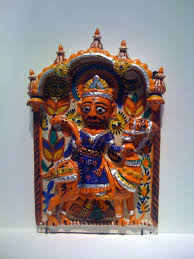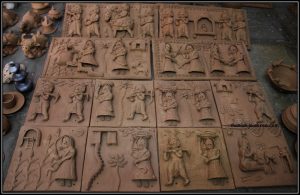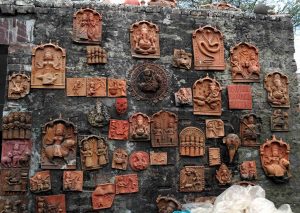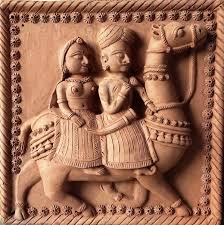When it comes to devotion and worshipping we can find various ways of expressing gratitude to the supreme soul. Among these, today, we are going to discuss one such worship which is also an art of engraving divine symbols and images of gods on clay plaques typically taken up by natives of Molela.
The Mina and Bhil tribal’s of Molela along with other groups like Gujars and Garijats, every year during the month of January, these tribes travel to Molela to buy clay plaques to worship. These plaques are also termed as votive icons and they are replaced in every three to five years as a gratitude to the blessings they received.
Here too men and women both share the work equally to make votive plaques and domestic clay vessels. Women do the task of getting the clay ready while the men make the murtis for worship and decorate them. This traditional manufacturing art of clay plaques is passed on from generation to generation and each generation it evolves into something different and beautiful.
Now we shall discuss about the preparation of the clay plaques. The plaques are specially made with red clay of Molela which is found on the banks of the nearby pond. For strengthening and tempering of clay, husk and donkey dung are well kneaded into it. It is said that winter is the suitable time for making the murtis as in summer they are prone to develop cracks and break due to heat. Once the clay is kneaded to the right consistency, the crafts men begin the work. There is no wheel or mould used in the making and the whole process is made by hand.
Pindi is used for flattening and pounding of clay. The slabs are prepared first. The clay slab is smoothened with small flat piece of wood. Then the image of the idol is carefully crafted on the slab or tile. Addition of small round urns are the most common arts inserted into the idols. The design and the line work are done with a baldi, a small flat chisel like instrument made of metal. The ends of the baldi are used like one end for drawing lines and patterns on the clay and the other end for making holes.
These prepared murtis are allowed to dry in the sun until they are considered ready for firing. The colour is also decided before firing process starts. If people choose normal terracotta colour, then red terracotta powder is mixed with gum and is used to cover the murti before firing. The murtis are made to stand in an open kiln, covered with cow dung and shards of pottery. However, it must be seen that the temperature is steady and constant in this process. After firing is done, bright water colours are used to decorate the freshly baked murtis.
Idols of both male and female are made here like Ganesh, Nagadev, Goddess Durga, Dharmaraj, Dev Narayan etc. Also people of great importance and epic value from folk legends dating back in time who have now taken form of divine powers are also crafted here.







